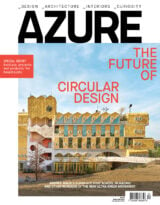
The pioneering teaching methods of Loris Malaguzzi (1920–1994) and his fellow educators in the Italian town of Reggio Emilia hold that a teacher’s role is not to instruct children on a standardized set of topics but rather to guide them in rich encounters with the world. A key pillar of their pedagogy is that a school’s building is yet another teacher. It’s a philosophy that continues to inform many of today’s most forward-thinking education projects.


Hence, when adopting the Reggio Emilia approach for its new school in Madrid, Spain, Colegio Reggio turned to New York- and Madrid-based firm Office for Political Innovation (OFFPOLINN) to develop an appropriately inspiring environment. The radical building that the team came up with places equal emphasis on experiential learning and environmental sensitivity. “It avoids unification or homogenization,” says Andrés Jaque, OFFPOLINN’s founder and the current dean of Columbia’s architecture school. “Instead, it’s a way for architecture to render the complexity of the environment perceptible. Parts of it operate as civic infrastructure, others as gardens, and some within the tradition of light cabin construction.”

Work began just before the pandemic, and Colegio Reggio welcomed its first students in September 2022. Located on a sloped plot at the edge of Madrid’s upscale and mostly low-rise Encinar de los Reyes neighbourhood, it faces off against some of the city’s most expensive housing developments and exclusive private schools — where tartan uniforms evoke the rigid formality of old English boarding schools.


Reggio’s vertical and highly individualistic facade reads as a declaration of independence against this flat, posh conformity. Porthole-like windows and large expanses of glass block create an artfully haphazard rhythm as they wrap around each floor. And while the six-storey structure is largely assembled from concrete and steel, its massing, zigzagging roofline and cork-based cladding suggest a far more handmade work, as if a giant sculptor stacked together the various elements that one expects in a school — classrooms, a gymnasium, a playground — and bound them up with clay.

Behind the school lies Valdebebas Forest Park, a greenbelt of recently planted saplings that stretches across the northern part of Madrid. “The school is located in between very different suburban and natural landscapes,” explains Jaque. “It’s part of a recent zoning strategy intended to bring a diversity of uses into the residential periphery while also articulating the ecologies of the natural corridor to the south.” Adds OFFPOLINN studio director Roberto González, “The school acts as a visual link between those structured and more organic environments.”

The interior extends this dynamic. To imbue students with a better understanding of how a building functions (and to make the most of the modest budget), mechanical ducts, plumbing and ventilation systems are all left exposed. With no need to hide these entrails with drop ceilings and the like, construction materials were cut by a whopping 48 per cent. Distributing the 5,942-square-metre facility vertically rather than horizontally further reduces the building’s footprint.


Believing that a diverse mix of age groups helps introduce students to different perspectives, Colegio Reggio teaches everyone from newborns to 18-year-olds. The school’s youngest children occupy the ground level, giving them direct access to the playgrounds outside. Older students head upstairs, where classrooms and science labs surround a verdant skylit atrium that acts as a dynamic social hub while also promoting everyday observations about plant life. This garden also serves as a natural climate shock absorber, taming the extremes of Madrid’s winter and summer temperatures. In lieu of air conditioning, windows are positioned to create comfortable cross-breezes.


Similarly, the 15-centimetre-thick butterscotch-hued cork coating sprayed on the building’s exterior harnesses the natural material’s inherent insulation properties. Just as Colegio Reggio is welcoming Madrid’s young minds, this cork is expected to attract colonies of lichen and fungi; small exterior gardens on each level are also landscaped to lure wildlife like birds, bats and butterflies. The result is a textbook come to life — a building where lessons are not so much taught as they are experienced. As Jaque puts it, “For us, architecture does not accommodate life: architecture is life itself.”
Office for Political Innovation teaches a lesson in wonder — and minimizing our impact on the land.
